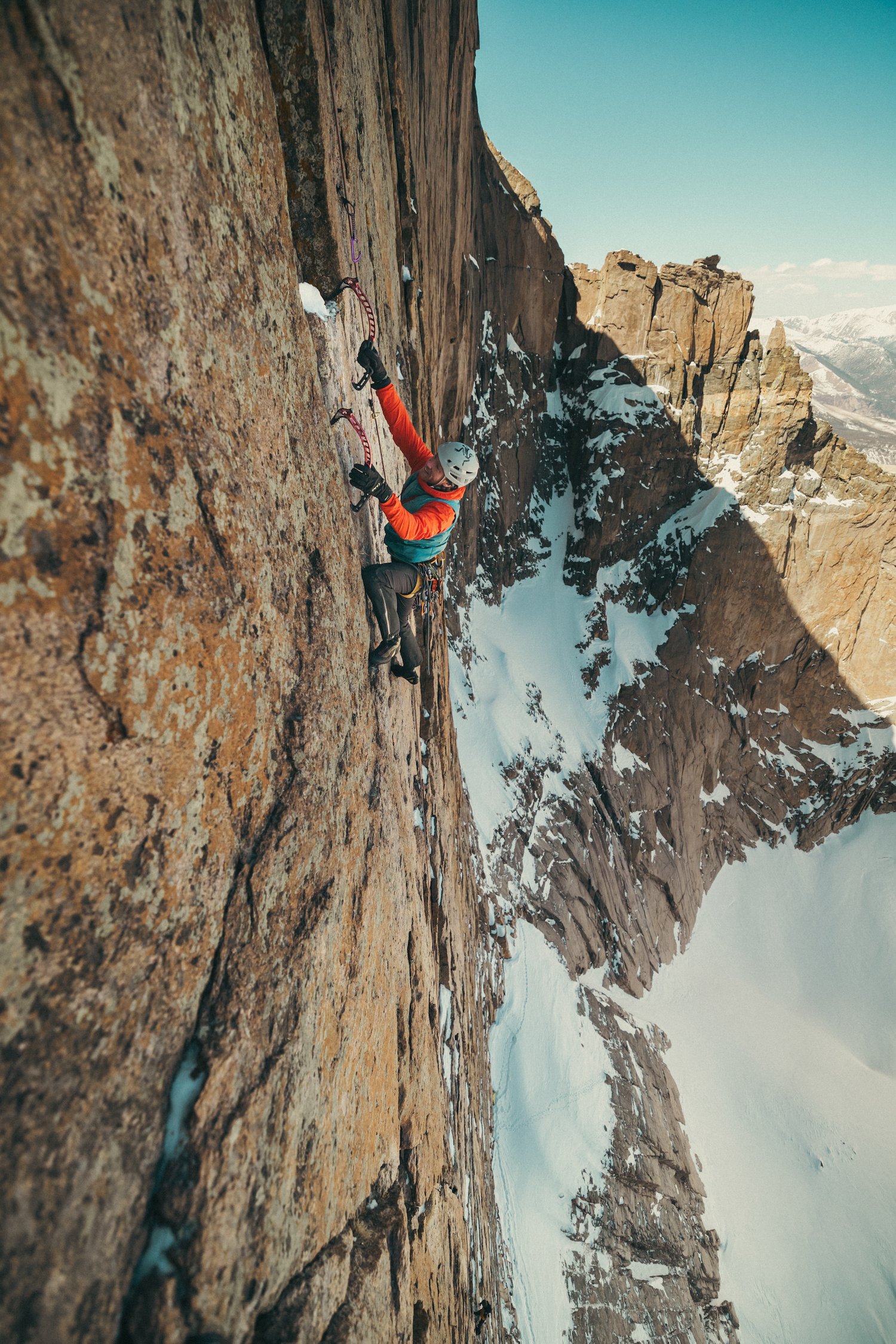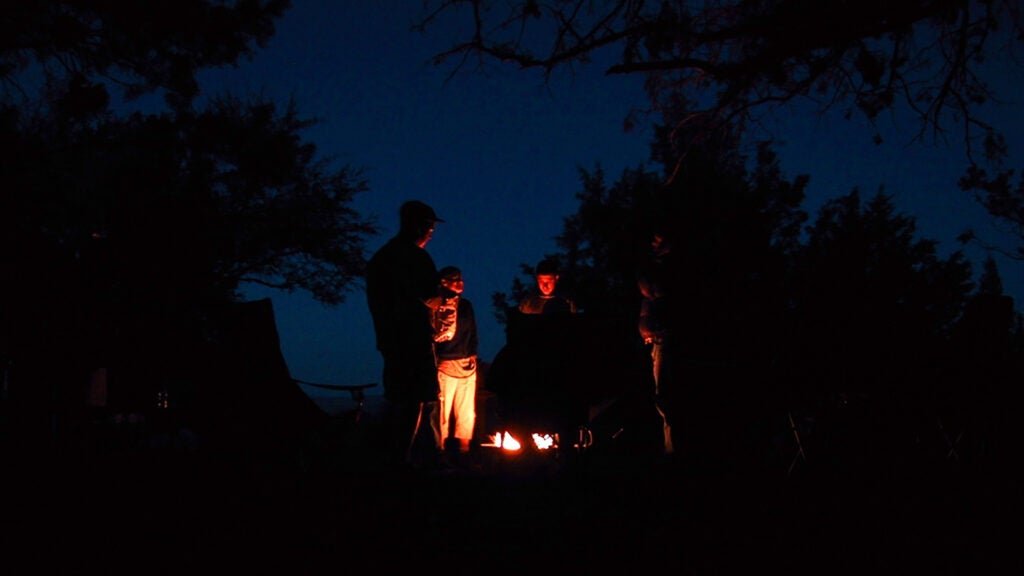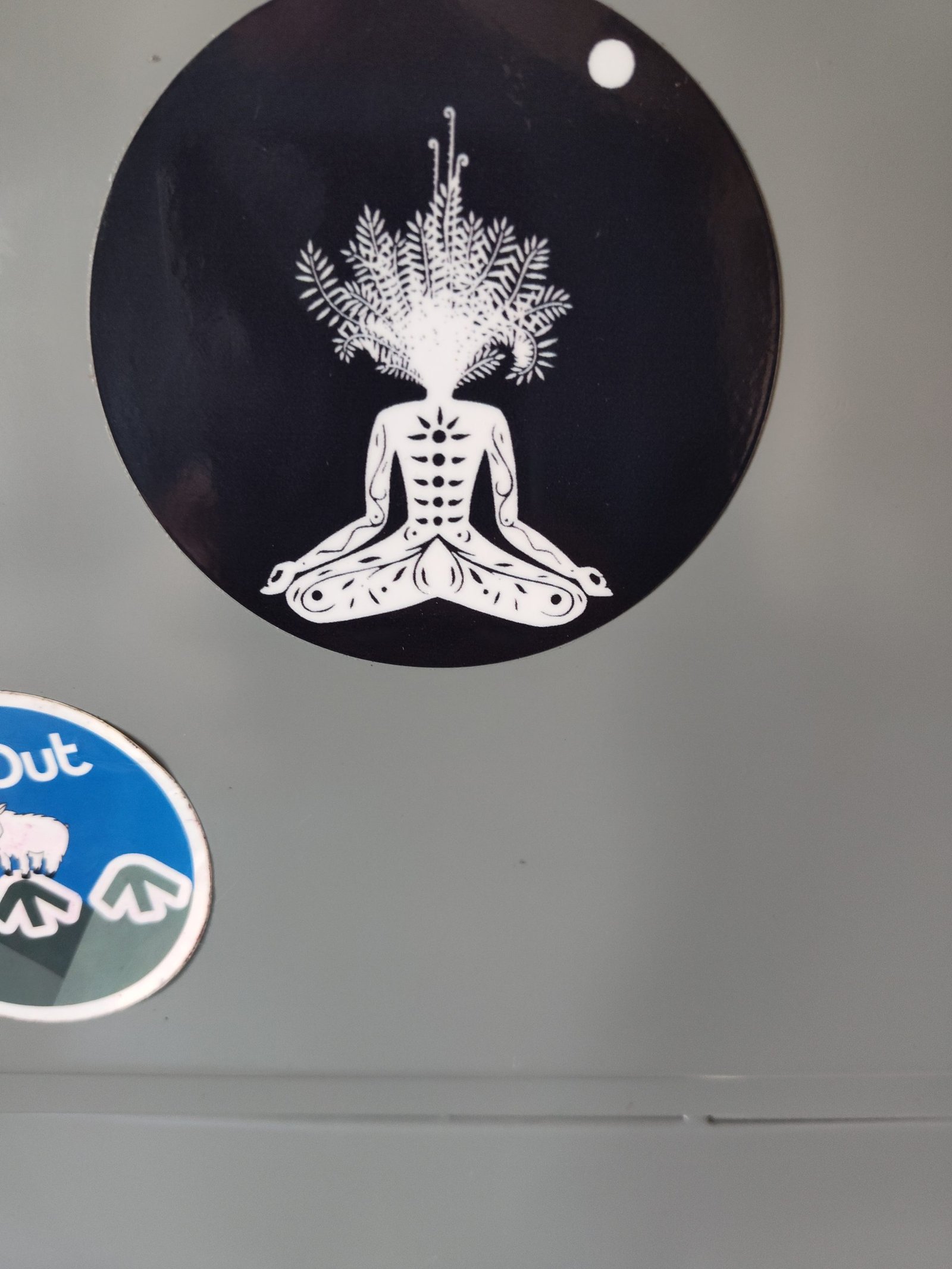Destinations & Things To Do
A mixed-style free ascent of the Diamond in winter, sans crampons

Colorado climbers Jesse Huey, Matt Segal and their Canadian friend Quentin Roberts recently completed a winter, mixed-style free ascent of D7 on the Diamond of Longs Peak (Neniisoteyou’u, 14,255′). Though they used ice axes to drytool the thin cracks of the 5.11+ route, they did not use crampons to avoid leaving scratch marks on one of the state’s most classic alpine climbs. There were also short sections that required bare hands to climb. All three climbed the ca. 600-foot route without jumaring to clean and follow the pitches.
“A team free ascent was really important to all of us,” Huey told Alpinist over the phone. He said that style was much slower than having a dedicated supporter following on jumars. “Transitioning from freezing at the belay to climbing took time,” he said. A key strategy was carrying down booties on their harnesses to change into at belays, rather than lugging up heavy boots.
Besides that, they made extra accommodations to include photographer Jon Glassberg.
They set out March 11 and summited March 13 after spending two nights on Broadway ledge, which sits at about 13,000 feet at the base of the Diamond. Huey said that they had reached the top of the crux pitch at around 4 p.m. March 12. With two pitches remaining, they could have likely finished the remaining two pitches and summited late in the day, Huey said, but they decided to rappel and re-lead the pitch for top-down photos. They jumared to their high point on March 13 and finished the climb in time for sunny summit photos. Huey expressed mixed feelings about the compromised style for the sake of documenting the climb.
Huey has made at least one attempt each calendar winter since 2018 to free climb D7, with Segal joining him since 2020. When Roberts agreed to partner with them for this season’s attempt, they had a team with substantial experience on extreme alpine routes.
In 2023, Huey, Segal and California granite ace Jordan Cannon completed the second free ascent of Cowboy Direct (VII 5.13) on Trango (aka Nameless) Tower in Pakistan. The conditions for free climbing at 6251 meters (20,509′) in summer were significant, not unlike what they recently encountered at nearly 14,000 feet on the Diamond in winter.
As for his part, last November Roberts and his partner Alik Berg received a Piolet d’Or for their 2022 ascent of a new route, Reino Hongo (M7 AI5+ 90°, 1000m), on the south-southeast spur of Jirishanca (ca. 6094m), Cordillera Huayhuash, Peru. (An interview with Roberts about his career was recently published on The Enormocast podcast.)
Huey said that having a third person to share the load and the chores, such as melting snow for water, made a huge difference.
On December 21, 2024, the first calendar day of winter, Chris Deuto completed a rope-solo free ascent of the Casual Route (IV 5.10a). He climbed bare-handed and sustained some frostbite. (A interview with him can be found on The Runout Podcast.)
“It’s been a low-snow year, for sure,” Huey said. Good winter free-climbing conditions on the mountain translated to highs above 70°F around Boulder, he added. “It was so much more tempting to just enjoy fun, sunny conditions around here.”
But Huey has been feeling the clock ticking to finish his bucket-list objectives because his wife is expecting to deliver their baby this spring. “I’m trying to get it all done!” he said.
Destinations & Things To Do
Top 5 most booked Asian travel destinations in early 2025 – Moneycontrol
Destinations & Things To Do
My Favorite Part About Outdoor Skills Is Learning Them

Readers of Outside’s summer skills package: I envy you. As you read stories about starting a fire, or sharpening a knife, and put those lessons into practice, you’re entering an entirely new world full of exciting discoveries, curiosity, and abilities. The process of learning is one that too often feels intimidating. But being bad at stuff isn’t just a necessary part of the skill-learning process; it’s also often the most enjoyable.
One of the things you experience as you learn new skills is freedom. The freedom to be bad at something. Without the weight of other people’s expectations, or pressure to perform, you’re free to simply to focus on the experience.
These days, when I start that fire, or hand someone a knife, there need to be flames and that knife has to be sharp. If there’s not or it isn’t dinner, will be delayed and let downs will be felt. Events will transition from smooth progress into a problem. The time is no longer there for a mistake or an oversight during preparation. But you are given that time try stacking the wood a different way, or going back to your car for a different form of fire starter. Your project can become a fun activity for the entire group. Like solving a jigsaw puzzle with friends—one that won’t be spoiled if you end up serving the hot dogs cold alongside it.
You also get to look at everything in that campsite with fresh eyes. That rock over there? That could help support a fire ring! Will this log light better than another because it feels lighter? That’s discovery. The humble experience of building a campfire feels like nothing but, because it’s exciting and new.
Challenge is a feature in the learning process, not a bug. Shit happens, and learning to deal with it is the learning you need to master a skill. Discovering your firewood got soaked in an overnight downpour is a reminder to store it out of the weather, sure, but it’s also an opportunity to learn to split it open with your knife and expose its dry center. A slip during the process is a chance to practice first aid and a reminder to be a little more careful.
As those lessons add up, you’ll be able to take them further and rely on them more. A simple car camping trip to a site with picnic tables and metal fire rings might feel like a big adventure now, but after making some mistakes in that relatively safe environment, or forgetting to bring something in a place where goods can still be purchased or borrowed, you’ll be equipping yourself with the knowledge you need to scale into new environments that involve more consequence.
A night out in a commercial campground is great. With stars in the sky and marshmallows (hopefully) roasting over a fire, the simple pleasure of time outdoors doesn’t get much more pure. And you have total control over where you take things from there. Want to start that fire away from other people, worn out from walking all day? Maybe you’ll throw on a backpack, learn some lessons about water purification, and start a fire way out in the woods, where you’ll know what kind of sticks to pick up to get one going as easily as possible. Or maybe you’ll push your camping trips further into the fall, when there’s risk of snow, and your newfound ability to ensure everyone can get warm starts to feel less like a novelty and more essential.
As you stare at your campfire, feeling safe and whole inside an unknown environment, you might find yourself contemplating the countless generations of human who have done just that before you. Or maybe even the importance of ensuring future generations will be able to do the same. As the outdoors becomes a part of your life, you may start considering how you can help protect it.
Somewhere between the excitement of that first campfire and forgetting there was a time when you did’t know how to make one, you may also discover a desire to share the experience with other people. To teach them the skills that you learned, and that will bring an excitement all of its own.
Inherent to the task of teaching is the responsibility to keep pursuing mastery—and the opportunity to see the outdoors and all its wonder through a fresh set of eyes. In taking that on, you give yourself a reason to keep learning and keep finding novel solutions, along with the more immediate satisfaction inherent in watching someone learn.
And as you help someone else hone the skills necessary to enjoy the outdoors, you are also creating a fellow traveler. Someone you can enjoy experiencing nature with, of course, but also an ally in helping you protect it. Because, as you learn the skills necessary to go from a novice to an expert, you’re also learning about your own place on this planet and the important role we humans play in nature. It’s a role you now know the importance of fulfilling.
Destinations & Things To Do
Little Rock Pond – The Trek

Day 92- 17 Miles today from Bromley Mountain Ski patrol hut to Little Rock pond shelter, 2,400 Feet Up, 3,500 Feet down, AT Mile Marker 1,678
The Ski Hut
I arrived at the summit of Mount Bromley about 5:00 p.m. and I could see a storm off in the west heading in my direction. The views from the top of Mount Bromley were spectacular 360 degree views of large mountains all around.
The ski patrol hut was an enclosed building with windows, a small kitchen, picnic table, and several 2 foot wide platforms. I found a container of permethrin that had someone had left behind so I used the rest of the container up on my hiking clothes.
While being inside a building was nice it was a small building and I felt exposed. This was not like a shelter in the woods. This was an area that day hikers frequent. I have to admit it was a bit unsettling being alone inside this building.
I dozed off about dark and for the most part slept through the night. I woke a few times when I heard a noise.
Stroll On
This morning the top of Mount Bromley was fogged in. I haven’t had too much luck with some of the most spectacular views.
It was mindless stroll down to Mad Tom Notch Road. I was moving along at a fairly fast pace of approximately 2 miles per hour and then began the climb up Styles peak.
The trail meandered through a dense spruce and birch forest. After climbing it went along a ridge that looked like it had nice views on either side but the density of the forest kept the views hidden.
Water Source
I then descended steeply down to Upper Lake Brooke area. The Upper Lake Brooke was the first water source since yesterday. I had plenty of water because I took enough water up Mount Bromley yesterday in preparation for this long water carry. I was down to about a third of a liter.
I guessed that the waterfall ahead would be inundated with mosquitoes and flies so I stopped about 3/4 of a mile from the water source in a sunny area hoping that would reduce the amount of flies and mosquitoes that would attack me while I ate my cold soak ramen.
It was noon and I had only passed one hiker heading southbound all day. We both said hello but both of us seem to be on a mission to carry on in our respective directions so we didn’t even stop to talk.
Shower Time
Just shortly after stopping to eat I came up on a small brook and decided I would get my water there. I was also able to use my smart water bottle cap that I drilled a bunch of holes in to make a little shower cap out of. Using my doctor Bronners soap I washed all the important parts of my body.
I was disappointed to look at the speed that I’ve been traveling at overall today. I’ve only been going about 1.5 mph. I had only gone 7 miles and still had 10 more miles to go.
Around Peru Peak shelter there were endless boardwalks to walk down. It seemed to go on forever.
The trail continued on with some technical parts of rocks to navigate around.
Creek Symphony
The path came out to a nice flat section where I could finally pick up some speed again. After passing Lost Pond the trail continued to parallel to a babbling creek. I couldn’t see it but I could hear it. I took my earbuds out so that I could listen to the rolling water in the woods next to the trail.
Eventually the trail led to Big Branch which was the size of a small river and had lots of little waterfalls on it. A huge 50-ft long suspension bridge spanned the little gorge where the Big Bend traveled through.
Crowds of People
I still had three and a half more miles left in my day.
The trail came out on FS10 and a parking area that was packed full of cars. I had heard that my destination Little Rock Pond was a big day use area.
The trail meandered along a nice small babbling creek all the way up to the shelter. After a day of seeing few people I now continued to pass multiple day hikers on my way to the shelter.
The shelter was packed with church group but I found the last spot in the shelter and set up for the night.
This website contains affiliate links, which means The Trek may receive a percentage of any product or service you purchase using the links in the articles or advertisements. The buyer pays the same price as they would otherwise, and your purchase helps to support The Trek’s ongoing goal to serve you quality backpacking advice and information. Thanks for your support!
To learn more, please visit the About This Site page.
-

 Brand Stories2 days ago
Brand Stories2 days agoBloom Hotels: A Modern Vision of Hospitality Redefining Travel
-

 Brand Stories1 day ago
Brand Stories1 day agoOlive Living: India’s Intelligent, Community-Centric Hospitality Powerhouse
-

 Destinations & Things To Do3 days ago
Destinations & Things To Do3 days agoUntouched Destinations: Stunning Hidden Gems You Must Visit
-

 AI in Travel3 days ago
AI in Travel3 days agoAI Travel Revolution: Must-Have Guide to the Best Experience
-

 Brand Stories3 weeks ago
Brand Stories3 weeks agoVoice AI Startup ElevenLabs Plans to Add Hubs Around the World
-

 Brand Stories2 weeks ago
Brand Stories2 weeks agoHow Elon Musk’s rogue Grok chatbot became a cautionary AI tale
-

 Asia Travel Pulse3 weeks ago
Asia Travel Pulse3 weeks agoLooking For Adventure In Asia? Here Are 7 Epic Destinations You Need To Experience At Least Once – Zee News
-

 AI in Travel3 weeks ago
AI in Travel3 weeks ago‘Will AI take my job?’ A trip to a Beijing fortune-telling bar to see what lies ahead | China
-

 Brand Stories3 weeks ago
Brand Stories3 weeks agoChatGPT — the last of the great romantics
-

 The Travel Revolution of Our Era1 month ago
The Travel Revolution of Our Era1 month agoCheQin.ai Redefines Hotel Booking with Zero-Commission Model

